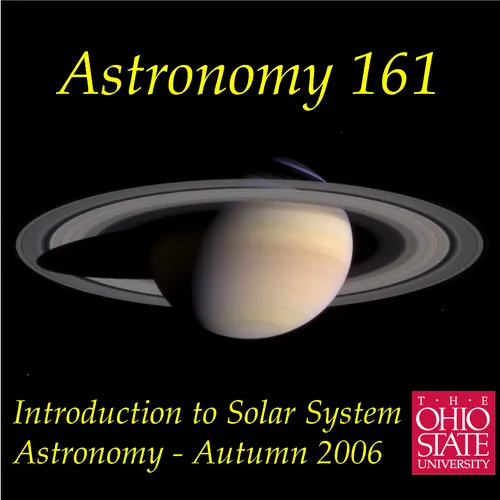
Astronomy 161 - Introduction to Solar System Astronomy
Astronomy 161, Introduction to the Solar System, is the first quarter of
a 2-quarter introductory Astronomy for non-science majors taught at The
Ohio State University. This podcast presents audio recordings of
Professor Richard Pogge's lectures from his Autumn Quarter 2006 class.
All of the lectures were recorded live in 100 Stillman Hall on the OSU
Main Campus in Columbus, Ohio.
- Update frequency
- every day
- Episodes
- 47
- Years Active
- 2006 - 2009

Astronomy 141 Podcast Teaser
A new podcast, Astronomy 141, Life in the Universe, is available
for those interested in continuing an exploration of topics in
modern astronomy.
Sun 06 Dec 2009

Lecture 46: ExoPlanets - Planets around Other Stars
Are there planets around other stars? Are there Earth-like planets
around other stars? Do any of those harbor life? Intelligent life?
We'd like to know the answers to all of these questions, and i…
Fri 01 Dec 2006

Lecture 45: Is Pluto a Planet?
What is a planet? Is Pluto a planet? This lecture traces the debate on
the nature of what it means to be a planet by taking an historical approach,
looking at how the question has arisen with the …
Thu 30 Nov 2006

Lecture 44: Comets
Comets are occasional visitors from the icy reaches of the outer Solar
System. This lecture discusses the orbits, structure, and properties of
comets, and introduces the "dirty snowball" model of a …
Wed 29 Nov 2006

Lecture 43: Icy Worlds of the Outer Solar System
Beyond the orbit of Neptune is the realm of the icy worlds, ranging in
size from Triton, the giant moon of Neptune, and the dwarf planets Pluto
and Eris, all the way down to the nuclei of comets. Th…
Tue 28 Nov 2006

Lecture 42: Asteroids and Meteoroids
Asteroids are the leftover rocky materials from the formation of the
Solar System that reside mainly in a broad belt between the orbits of
Mars and Jupiter. Meteoroids are fragments of asteroids or …
Mon 27 Nov 2006

Lecture 41: Planetary Rings
All Jovian planets have rings. We are most familiar with the bright,
spectacular rings of Saturn, but the other Jovian planets have rings
systems around them. This lecture describes the different r…
Wed 22 Nov 2006

Lecture 40: The Saturn System
Saturn is attended by a system of 56 known moons and bright, beautiful
rings. The Moon system is the focus of our attention today. Saturn has
one giant moon, Titan, which is the 2nd largest moon in…
Tue 21 Nov 2006

Lecture 39: The Moons of Jupiter
Jupiter is surrounded by a solar system in miniature of 63 known moons.
Most (59) are tiny, irregular bodies that are a combination of captured
asteroids and comets. The 4 largest are the giant Gali…
Mon 20 Nov 2006

Lecture 38: Uranus and Neptune
Uranus and Neptune are the smallest and outermost of the 4 Jovian
planets. While superficially similar to Jupiter and Saturn, there are
substantial differences. Uranus and Neptune have smaller rock…
Thu 16 Nov 2006

Lecture 37: Jupiter and Saturn
Jupiter and Saturn are the largest planets in the Solar System,
and the prototype of the Jovian Gas Giant planets. This lecture
focusses on the planets themselves, looking at their composition,
atmo…
Wed 15 Nov 2006

Lecture 36: Worlds in Comparison - The Terrestrial Planets
Having completed our tour of the terrestrial planets, we want to step
back and compare their properties. In particular, we want to look at
the processes that drive the evolution of their surfaces, t…
Tue 14 Nov 2006

Lecture 35: The Deserts of Mars
Mars, fourth planet from the Sun, is a cold desert planet with a thin,
dry carbon-dioxide atmosphere. The geology of Mars, however, shows
signs of an active past, with hot-spot volcanism, and tantal…
Mon 13 Nov 2006

Lecture 34: Venus Unveiled
Venus, the second planet from the Sun, is perpetually veiled behind
opaque clouds of sulfuric acid droplets atop a hot, heavy, mostly carbon
dioxide atmosphere. In size and apparent composition, how…
Thu 09 Nov 2006

Lecture 33: Battered Mercury
Mercury is the innermost of the planets, a hot, dead world that has been
heavily battered by impacts. This lecture reviews the basic properties
of Mercury, particularly its surface and interior. Re…
Wed 08 Nov 2006

Lecture 32: The Origin of the Solar System
How did the Solar System form? This lecture examines the clues in the
present-day dynamics (orbital and rotation motions) of the planets and
planetary composition to the formation of the solar syste…
Tue 07 Nov 2006

Lecture 31: The Family of the Sun
We start our exploration of the Solar System with a quick overview of
its constituent parts. I will take as my starting point that Pluto,
Eris, and Ceres are Dwarf Planets according to the 2006 IAU …
Mon 06 Nov 2006

Lecture 30: The Moon
What is the structure of the Moon, and what physical processes have
shaped its surface? In this lecture we turn to our nearest celestial
neighbor, the Moon, to see a world quite different than the d…
Thu 02 Nov 2006

Lecture 29: The Earth's Atmosphere
What is the composition and structure of the Earth's atmosphere? Why is
it as warm as it is, and how did it form? These are the questions for
today's lecture. The Earth's atmosphere is a complex, …
Wed 01 Nov 2006

Lecture 28: Inside the Earth
What is the structure of the Earth? What better place to begin our
exploration of the Solar System then with the best-studied planet, the
Earth. This lecture discusses the interior structure of the…
Tue 31 Oct 2006
Disclaimer: The podcast and artwork embedded on this page are the property of Richard Pogge. This content is not affiliated with or endorsed by eachpod.com.